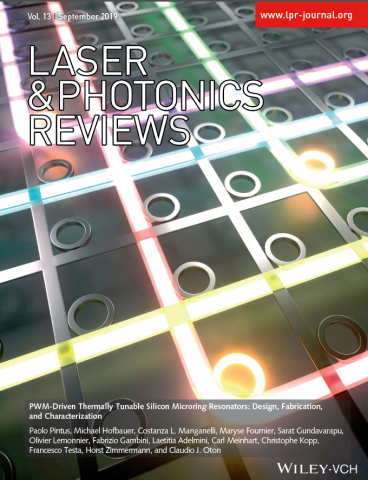“Lasers & Photonics Reviews” Journal cover provides a focal point for a Sant’Anna School - CNIT research paper on silicon photonics

Recent advances in the development of silicon photonics presented by TeCIP Institute and CNIT Laboratory researchers are featured on the cover of September 2019 issue published in “Lasers & Photonics Reviews”. Researchers have worked on highly integrated and fully reconfigurable opto‐electronic switches i.e. silicon microrings based on the thermo‐optic effect to improve foundry‐compatible architectures enabling a wide variety of applications like interconnection of cores in low‐power, cost‐effective, high‐performance computing systems in next generation data centers.
Over the past five years, researchers have provided a comprehensive optimization framework and experimental results of thermally tunable microring resonators in silicon photonics. To minimize the total power consumption, the ring resonators were tuned by applying a pulse‐width‐modulated (PWM) electrical signal to the heaters. The thermal performance of integrated silicon and metal heaters were investigated and compared using an effective model validated by the measurement results. The heater power consumption was minimized by optimizing configuration and improving efficiency from 30 to 90 percent.
The Pisa Sant’Anna-CNIT research team consisting of Paolo Pintus, Costanza Manganelli, Fabrizio Gambini and Claudio Oton has presented a standardized design framework for improvement of performance and reduction of cost, with a focus on standard silicon photonic foundry processes. The framework, accounting for the integration constraints of both electronic and photonic foundries will pave the way for complex system‐on‐chip applications. The development of a standardized rule‐set for designing foundry‐compatible architectures will serve as a toolbox to enable on‐chip reconfigurable optical signal routing in a wavelength division multiplexing (WDM) system.
“The proposed framework, supported by the experimental results, will serve as a design guideline set that can be easily adapted for other thermo‐optic switches in future silicon photonic applications. Despite their susceptibility to temperature variations due to the large thermo-optic coefficient of silicon, these new applications have shown resilient behavior to ambient fluctuations. For an architecture to remain feasible, the disparity in spectral properties and input-output relationships of WDM channels in these systems must remain in a certain range. The challenge is to improve foundry-based routes to transient silicon electronic devices as secure data center systems”, said Paolo Pintus, first author of the paper, currently working at the University of California Santa Barbara, USA.
Paper authors include scholars from the Technische Universität – Wien, CEA-Leti Lab. - Grenoble, University of California - Santa Barbara, and ERICSSON Pisa R&D team.
Click here to download the paper.




